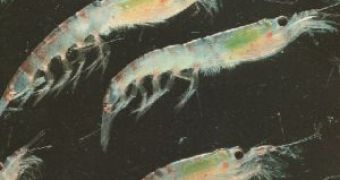Krill (photo), tiny plankton eating crustaceans which form huge schools on sea, effectuate daily migrations up and down in the water, bringing up nutrients from the depths and having a big impact on ocean life. Krill is present in such big numbers in the world's oceans that its biomass equals the animal protein consumed by humans yearly. Only Antarctic krill is estimated at 50 to 150 million tonnes.
Its migration could contribute to mixing gases in the ocean waters, influencing the way in which gases like green house effect carbon dioxide get trapped in the depths. The biologically generated turbulence may have a previously unappreciated effect on climate change.
Scientists could not completely explain the abundance of ocean life at the surface, since predictions didn't present a rise of enough nutrients from the abyss. Wind, tides, waves and upwelling currents were long considered the main sources of mixing, but microscopic plankton algae at the ocean's surface seemed to receive more nutrients from below than these physical mechanisms could explain.
A study at the University of Victoria in Canada, investigated krill banks in Saanich Inlet, a fjord on Vancouver Island. In day time krill remains hidden from predators at 100 m depth. The krill got up to the surface at night time and descended at the day brake.
In the roughly 10-minute bursts of the krill migration, they rose turbulence by up to thousands of times. "This is a pretty short-lived pulse," Dower says. "You start to wonder--we know these krill are abundant everywhere--are we looking at a general phenomenon that simply hasn't been detected elsewhere?"
"I was initially skeptical that biologically linked turbulence could be significant. I was surprised at just how large it could be," said researcher Eric Kunze, an ocean physicist.
The results seem to indicate that krill and other daily school - formatting migrating organisms are critical in bringing nourishment up from the ocean depths, which are rich with nutrients released by surface sunk bodies. "The question now is how frequently and how significant any biologically linked turbulence really is," Kunze said.
The most likely animals to generate large amounts of ocean turbulence are roughly inch-sized creatures that travel together in large schools or swarms - he speculated - such as anchovies, sardines, herring or squid.
Extrapolating at similar mixing off coasts around the globe, scientists estimate that migrant organisms could be responsible for one third of all ocean mixing.
Geraint Tarling, of the British Antarctic Survey in Cambridge, UK, says that the turbulence generated by krill in the Southern Ocean may bring more micronutrients to the surface and enhance the growth of phytoplankton, the main food source of krill. "In effect, krill reap the rewards of their own efforts."

 14 DAY TRIAL //
14 DAY TRIAL //